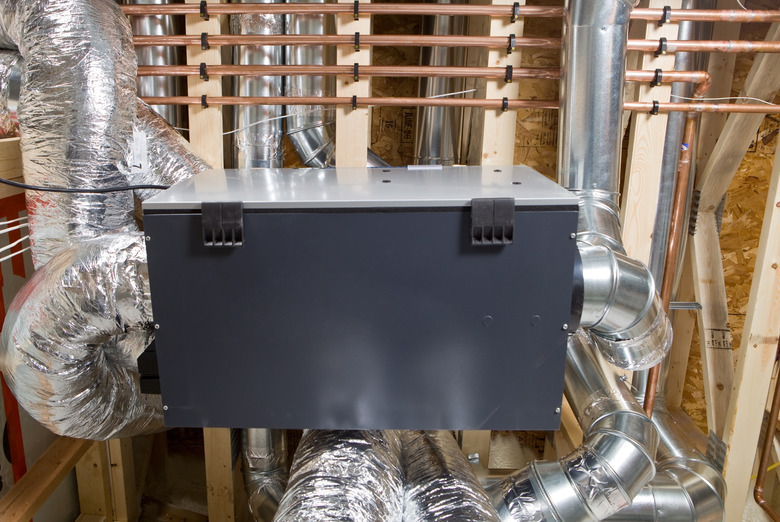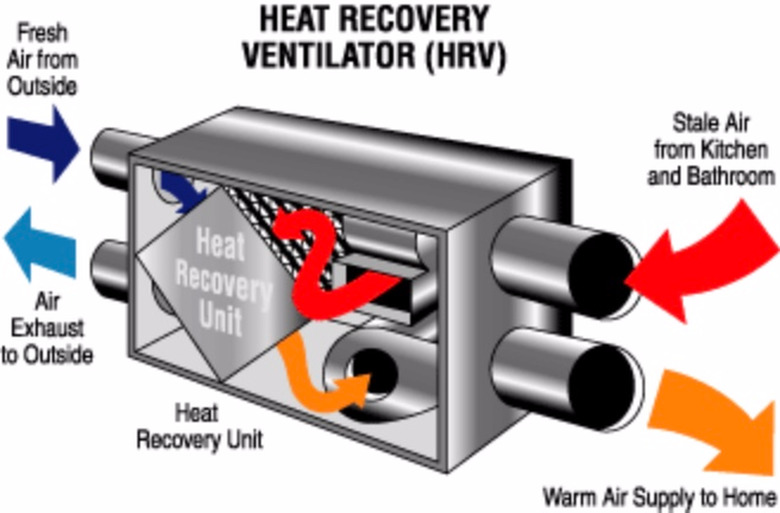Understanding Air Exchangers
A residential air exchanger is basically a system that moves fresh outside air into the house as it simultaneously exhausts stale indoor air to the outdoors. The advantage is the same as opening the vents on your car — to replace stale air with fresh air. If your HVAC system does nothing but blow around the same stale indoor air, your home remains full of dust and other impurities, which has documented health consequences. The EPA advises that the health detriments from breathing stale, dusty air are cumulative.
The value of air exchanger technology became more critical as home construction became steadily more air-tight due to efforts at preventing energy loss. Older homes with lots of gaps and cracks are really in no need of an air exchanger, but in modern, air-tight houses, an air exchanger may be more than a just a good idea — it may be required technology.
Among other virtues, air exchangers can help control mold. When the house is sealed to retain heat in winter and cool air in summer, moisture has no place to go. As the humidity increases, condensation collects and promotes mold growth. The spores get recycled through the heating system and cause allergies, respiratory problems and worse. You can avoid this by opening windows, but that defeats the purpose of the heating system, just as opening the windows in your car renders your car heater less effective. An air exchanger delivers fresh air without driving your heating and cooling bill into the stratosphere. They accomplish this by integrating some form of heat recovery technology along with the exchange of air.
How Air Exchangers Work
How Air Exchangers Work
An air exchanger is basically a box with two input ports and two output ports. Inside the box, a fan sucks stale air from the house through one of the input ports and exhausts it to the outdoors through the corresponding output port. Meanwhile, a second fan sucks in fresh outdoor air through another input port and sends it into the home's HVAC duct system through the corresponding output.
Some systems make use of the home's existing heating and cooling ducts and registers. In these systems, the fresh air passes through the actual heating and cooling system. Other systems are independent of the existing heating and cooling system and require installation of dedicated ductwork.
Air Exchangers Also Exchange Heat
Air Exchangers Also Exchange Heat
Air exchangers typically include some type of heat exchange system whereby heat from the warm indoor air being exhausted is transferred to the fresh air being sent back through the house. One way to accomplish this is to use concentric steel cylinders. As the warm air from the house passes through the inner cylinder or cylinders, it radiates heat to the outer cylinder that is simultaneously carrying air back into the house. Heat exchange can also be accomplished with plate-and-fin structures similar to automobile radiators.
A heat exchanger is therefore an important feature that saves energy by extracting the heat from stale indoor air before as it is being vented to the outdoors. The heat exchange capacity can also help with summer cooling costs by extracting heat from the air and sending it directly outdoors. Most heat exchangers have switches that allow the system to either keep heat indoors or facilitate its quick venting to the outdoors.
Air Exchanger Health Benefits
Air Exchanger Health Benefits
Air exchange eliminates pollutants, such as second-hand smoke and VOCs from paint, cleaning products and off-gassing carpeting. It also helps control moisture. The benefits of such a system include:
- An odor-free environment.
- Reduced risk of respiratory ailments and more serious diseases.
- A decrease in mold and mildew growth.
- A drier, more comfortable living environment.
Besides being full of unhealthful, odor-causing VOCs, indoor air is usually full of pet dander, dust mites, pollen and other allergens. If you have allergies, the last thing you want to do is recycle this air continually through the house. Although outdoor air might also contain allergens, it is usually at a lower concentration, and the air exchange system usually filters these out.
Your House Also Benefits
Your House Also Benefits
Your house doesn't like moist air, and you're constantly producing more of it by showering, using the dryer and dishwasher, and operating any appliance that burns propane or natural gas. Moisture deteriorates paint, promotes mold and fungi that cause wood rot, and makes your house more vulnerable to pest infestations. This is one reason why your house will love an air exchanger. And there's another one:
A continuous exchange or air balances the air pressure between the inside and outside of your house. In a sealed house without an air exchange system, one of two things can happen:
- The inside pressure can be greater than that outside, which subtly grinds dust and other pollutants into the walls and ceilings, discoloring the paint and fixing odors into the materials.
- The outside pressure may be greater than the pressure inside, which creates the possibility of backdrafts in a chimney. This type of pressure imbalance also forces outside air through cracks and gaps in the walls and increases your heating bill.
All air exchangers are designed specifically to balance the air pressure, so if you have one, your walls will stay cleaner and your fireplace will work better. Besides that, you'll be more comfortable and able to breathe more freely.


